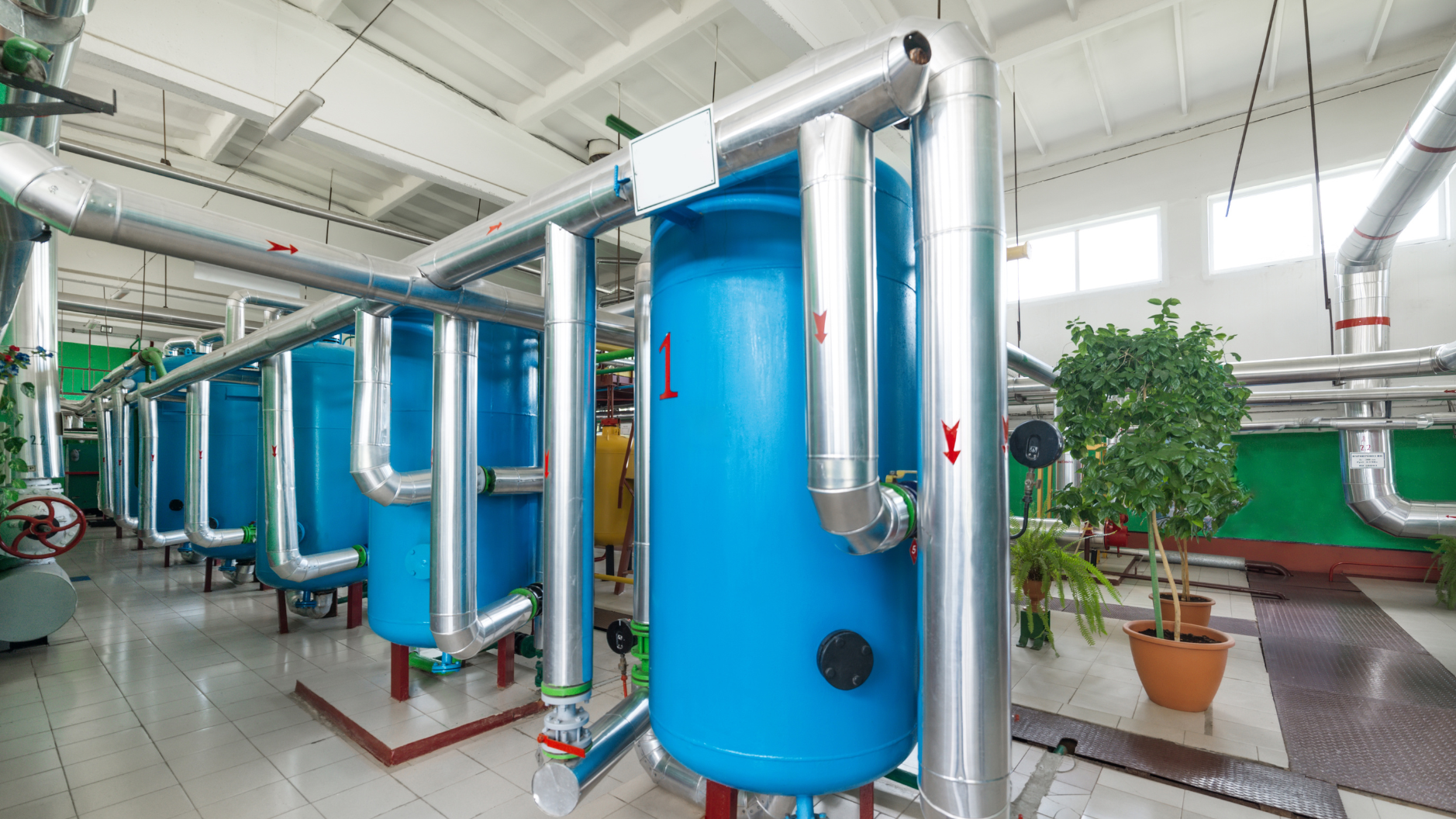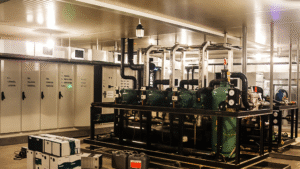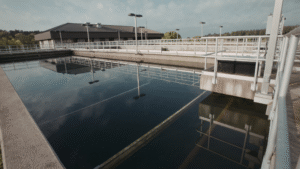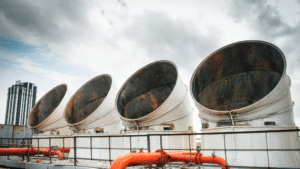For over 30 years, ETI has been the go-to chemical blender behind some of the most efficient, cost-effective, and environmentally responsible cooling tower programs in the country. We don’t compete with water treatment companies—we power them. Our expert formulations, precise blends, and green chemistry innovations help our partners deliver results that save energy, reduce blowdown, and protect critical infrastructure.
In this guide, we dive into the chemistry of cooling towers and how to choose the right chemical treatment package for your cooling water system to optimize performance, slash operational costs, and ensure proper water treatment from the start.
The Fundamentals of Cooling Tower Chemistry
Cooling towers function as large-scale heat exchangers, removing excess heat from industrial processes and dissipating it through evaporative cooling. As warm water cycles through the system, some of it evaporates, leaving behind concentrated minerals and impurities. Maintaining proper water treatment is essential to keep a cooling water system running efficiently and avoiding long-term damage. The three biggest threats to cooling tower efficiency are:
Scaling
When dissolved minerals like calcium, magnesium, and silica precipitate out of solution, they form scale deposits on heat exchanger surfaces. Even a thin layer of scale formation can reduce heat transfer efficiency and increase energy costs.
Corrosion
Water’s combination of natural conductivity and dissolved oxygen levels can cause metal components to corrode, leading to leaks, system failures, and costly repairs.
Microbiological Growth
Bacteria, algae, and biofilm thrive in warm water environments, clogging pipes, reducing flow efficiency, becoming pollutants and introducing serious health risks such as Legionella growth.
Benefits of Effective Cooling Tower Water Treatment
A proactive cooling tower water treatment program isn’t just good practice—it’s good business. Facilities that invest in a targeted water treatment strategy reap measurable benefits, including lower operating costs, improved reliability, and maximized equipment life. Here’s how:
Prevent Costly Corrosion
Corrosion silently shortens the lifespan of cooling towers and connected infrastructure. A targeted corrosion inhibitor chemical program forms a protective barrier on metal surfaces, safeguarding critical components and eliminating expensive equipment replacements and repairs.
Eliminate Energy-Wasting Scale
Scale buildup cripples heat transfer efficiency—just 1/32″ can slash efficiency by over 20%. Effective antiscalant programs keep heat exchanger surfaces clean, dramatically cutting energy costs. Industries relying on precise temperature control, like manufacturing, healthcare, and food processing, gain consistent, high performance throughout, reduced energy consumption, and substantial cost savings.
Consistent, Reliable Water Quality
Maintaining optimal water chemistry means fewer surprises. A structured water treatment program stabilizes water parameters, reducing unnecessary chemical usage, minimizing regulatory risks, and eliminating unexpected cooling tower system fluctuations—keeping operations predictable and trouble-free.
Reduce Downtime & Operational Costs
Unplanned shutdowns caused by corrosion, scale, or biological fouling are disruptive and costly. Facilities with robust water treatment avoid these headaches, minimizing emergency maintenance, preventing productivity losses, and significantly reducing operational expenses.
Optimize System Health
Efficient cooling towers use less energy, require fewer chemical interventions, and deliver reliable thermal control. A well-managed chemical treatment strategy means lower energy bills, fewer maintenance calls, and consistent performance—boosting your operational competitiveness and profitability.
Catch Problems Early (Proactive Monitoring)
Regular monitoring is your early-warning system, catching issues like pH swings, microbial growth, or scaling before they occur and they become costly failures. Routine water analysis empowers facility managers to proactively resolve minor imbalances, avoiding downtime and maintaining seamless operation.
Common Cooling Tower Water Treatment Strategies
Many facilities still rely on generic, off-the-shelf chemicals to combat scale, corrosion, and bio-growth. It’s inefficient, often incompatible, and leads to higher chemical loads and downtime. Here’s how a modern, chemistry-driven program should look:
Antiscalants
Antiscalants prevent mineral deposits on heat transfer surfaces. Without proper treatment and prevention, scale buildup severely reduces heat transfer efficiency, cripples performance, and can even force costly downtime for cleaning or equipment replacement.
Common scale inhibitors include:
- Polyphosphates: Good for mild conditions, but can create calcium phosphate deposits if misused.
- Phosphonates: Highly effective, slowing crystal growth—typically preferred over phosphates.
- Acrylate Polymers: Modify crystal structures, preventing adherence to surfaces.
- Copolymers (acrylate/sulphonated): Provide enhanced performance compared to traditional acrylates.
Corrosion Inhibitors
Corrosion eats away at your cooling system, shortening equipment life and increasing repair costs. Corrosion control inhibitors are essential, often combined with antiscalants compounds. Adjusting pH with sulfuric acid also reduces scaling risks, especially in larger systems.
Biocides
Microbial growth doesn’t just clog your system—it severely reduces heat transfer and creates health hazards. Biocides are used in cooling tower to handle biofilm and bacterial contamination effectively. They come in two varieties:
- Oxidizing Biocides: Fast-acting chemicals (like chlorine) that kill microorganisms through oxidation, rapidly eliminating bacteria and biofilm.
- Non-Oxidizing Biocides: Attack microbes by disrupting reproduction, respiration, or cell structure. Typically used continuously in small-to-medium systems, they’re chosen based on pH, retention time, microbial type, biodegradability, toxicity, and compatibility with other chemicals.
Dispersants
When solids settle, fouling begins. Dispersants help by keeping suspended solids moving, avoiding costly buildups. Organic dispersants often require large doses, making synthetic polymers the go-to choice. Key synthetic dispersants include:
- Low Molecular Weight Anionic Polymers: Highly effective, widely used dispersants.
- Cationic Amines & Quaternary Amines: Combat biological fouling effectively.
- Nonionic Polyacrylamides: Ideal for dispersing silt and clay.
Managing Legionella Risks: Safeguarding Health & Compliance
Legionella bacteria, the cause of Legionnaires’ disease, thrive in warm, stagnant water—making untreated or poorly managed cooling towers a potential health hazard. These systems can become reservoirs for bacterial growth if scale, biofilm, and poor circulation aren’t addressed.
An effective chemical treatment program integrates oxidizing and non-oxidizing biocides to control bacterial growth, coupled with dispersants that prevent biofilm formation—a known habitat for Legionella. Regular monitoring, water testing, and a structured treatment approach help ensure compliance with ASHRAE Standard 188 and other industry regulations, protecting both people and operations.
Key Factors in Selecting the Right Chemical Treatment Package
Your system is unique—and so is your water. However, traditional cooling tower water treatments often rely on multiple products, which complicates handling, increasing storage risks, and driving up operational hurdles.
Hence, when evaluating the right treatment strategy, consider the following critical factors:
- Water Source and Quality: Whether your facility uses municipal, well, or reclaimed water, each source presents unique challenges that require specifically tailored chemical solutions.
- System Conditions: Evaluate your system’s operational variables, including water temperature, flow rate, and cycles of concentration, to identify optimal treatment protocols.
- Compliance and Sustainability Goals: Look for treatments that not only ensure regulatory compliance but also align with your company’s sustainability objectives, reducing water usage, blowdown, and carbon footprint.
Choosing the Right Chemical Treatment Blender
Not all water treatment chemical blenders are created equal in the world of cooling towers. When selecting a company to provide your cooling tower chemistry, look for:
- Expertise & Experience: A seasoned chemical blender understands complex water treatment challenges and industry regulations. Their experience ensures effective solutions that enhance system performance and prevent costly failures.
- Customized Solutions: Every cooling tower system has unique water chemistry and operational demands. A quality blender formulates treatments tailored to specific conditions, ensuring efficiency and compliance.
- Use of Corrosion & Scale Inhibitors: Effective inhibitors prevent mineral buildup and metal degradation, extending equipment lifespan. The right blend balances protection and performance without unnecessary chemical use.
- Water Softening & Corrosion Control Methods: Hard water accelerates scaling, reducing heat exchange efficiency. A reliable blender integrates softening agents and pH control to maintain water quality and prevent damage.
- Experience in Industrial Processes & Cooling Systems: Industrial cooling systems require precise chemical dosing and adaptation to variable loads. A knowledgeable blender ensures consistent treatment to meet operational demands.
- Training and Technical Support: Beyond chemicals, a strong partner provides diagnostic support, troubleshooting, and ongoing training. This helps water treatment companies optimize performance and reduce costs for their clients.
ETI’s Approach to Cooling Tower Water Treatment
ETI’s advanced water treatment chemical programs focus on sustainability, efficiency, and cost savings. Our solutions to common challenges are built on eco-friendly chemistry principles, reducing reliance on multiple chemical products while delivering superior results for cooling tower water treatment. ETI’s innovative, sustainable approach simplifies these challenges by replacing 3-4 conventional chemicals with a single, highly effective green chemistry solution. This means less chemical handling, lower costs, reduced environmental impact, and consistent, powerful performance.
Through custom blending capabilities, ETI formulates solutions for it’s cooling tower water treatment partners that align with each facility’s unique operational requirements, ensuring peak performance and regulatory compliance.
Ready for the next steps?
The chemicals behind your cooling tower make or break its performance. At ETI, we specialize in blending smarter chemistries that help our partners achieve more—with less.
Ready to upgrade your chemical program? Contact ETI for an expert chemical evaluation. Let us show you what performance-driven chemistry really looks like.





